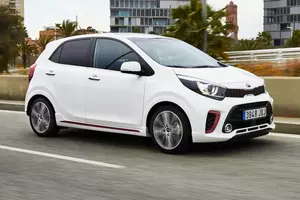
| Vehicle | Curb weight | Difference from world's smallest | Weight to power ratio | 0—60 mph acceleration ratio | Consumption ratio |
|---|---|---|---|---|---|
| 1.0 |
935 kg / 2062 lbs |
510 kg (1125 lbs) heavier | 14 kg to 1 hp | 69 kg/s (152 lbs/s) |
213 kg/L (470 lbs/L) |
| 1.2 |
959 kg / 2115 lbs |
534 kg (1178 lbs) heavier | 11 kg to 1 hp | 74 kg/s (163 lbs/s) |
178 kg/L (392 lbs/L) |
| 1.0 T-GDi |
933 kg / 2057 lbs |
508 kg (1120 lbs) heavier | 9 kg to 1 hp | 97 kg/s (214 lbs/s) |
207 kg/L (456 lbs/L) |
| Vehicle | 1.0 |
|---|---|
| Curb weight |
935 kg / 2062 lbs |
| Difference from world's smallest | 510 kg (510 lbs) heavier |
| Weight to power ratio | 14 kg to 1 hp |
| 0—60 mph acceleration ratio | 69 kg/s (152 lbs/s) |
| Consumption ratio |
213 kg/L (470 lbs/L) |
| Vehicle | 1.2 |
| Curb weight |
959 kg / 2115 lbs |
| Difference from world's smallest | 534 kg (534 lbs) heavier |
| Weight to power ratio | 11 kg to 1 hp |
| 0—60 mph acceleration ratio | 74 kg/s (163 lbs/s) |
| Consumption ratio |
178 kg/L (392 lbs/L) |
| Vehicle | 1.0 T-GDi |
| Curb weight |
933 kg / 2057 lbs |
| Difference from world's smallest | 508 kg (508 lbs) heavier |
| Weight to power ratio | 9 kg to 1 hp |
| 0—60 mph acceleration ratio | 97 kg/s (214 lbs/s) |
| Consumption ratio |
207 kg/L (456 lbs/L) |
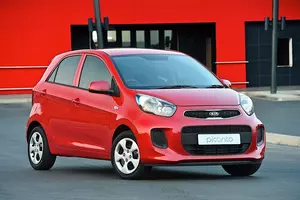
| Vehicle | Curb weight | Difference from world's smallest | Weight to power ratio | 0—60 mph acceleration ratio | Consumption ratio |
|---|---|---|---|---|---|
| 1.2 |
885 kg / 1951 lbs |
460 kg (1014 lbs) heavier | 10 kg to 1 hp | 68 kg/s (150 lbs/s) |
158 kg/L (348 lbs/L) |
| 1.0 |
940 kg / 2073 lbs |
515 kg (1136 lbs) heavier | 14 kg to 1 hp | 71 kg/s (157 lbs/s) |
204 kg/L (450 lbs/L) |
| Vehicle | 1.2 |
|---|---|
| Curb weight |
885 kg / 1951 lbs |
| Difference from world's smallest | 460 kg (460 lbs) heavier |
| Weight to power ratio | 10 kg to 1 hp |
| 0—60 mph acceleration ratio | 68 kg/s (150 lbs/s) |
| Consumption ratio |
158 kg/L (348 lbs/L) |
| Vehicle | 1.0 |
| Curb weight |
940 kg / 2073 lbs |
| Difference from world's smallest | 515 kg (515 lbs) heavier |
| Weight to power ratio | 14 kg to 1 hp |
| 0—60 mph acceleration ratio | 71 kg/s (157 lbs/s) |
| Consumption ratio |
204 kg/L (450 lbs/L) |
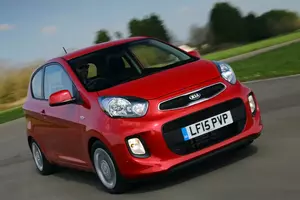
| Vehicle | Curb weight | Difference from world's smallest | Weight to power ratio | 0—60 mph acceleration ratio | Consumption ratio |
|---|---|---|---|---|---|
| 1.0 |
850 kg / 1874 lbs |
425 kg (937 lbs) heavier | 13 kg to 1 hp | 61 kg/s (135 lbs/s) |
193 kg/L (426 lbs/L) |
| 1.2 |
860 kg / 1896 lbs |
435 kg (959 lbs) heavier | 10 kg to 1 hp | 76 kg/s (168 lbs/s) |
187 kg/L (412 lbs/L) |
| Vehicle | 1.0 |
|---|---|
| Curb weight |
850 kg / 1874 lbs |
| Difference from world's smallest | 425 kg (425 lbs) heavier |
| Weight to power ratio | 13 kg to 1 hp |
| 0—60 mph acceleration ratio | 61 kg/s (135 lbs/s) |
| Consumption ratio |
193 kg/L (426 lbs/L) |
| Vehicle | 1.2 |
| Curb weight |
860 kg / 1896 lbs |
| Difference from world's smallest | 435 kg (435 lbs) heavier |
| Weight to power ratio | 10 kg to 1 hp |
| 0—60 mph acceleration ratio | 76 kg/s (168 lbs/s) |
| Consumption ratio |
187 kg/L (412 lbs/L) |
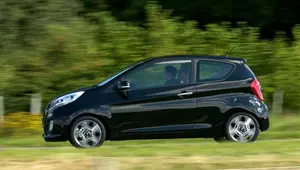
| Vehicle | Curb weight | Difference from world's smallest | Weight to power ratio | 0—60 mph acceleration ratio | Consumption ratio |
|---|---|---|---|---|---|
| 1.2 16V |
850 kg / 1874 lbs |
425 kg (937 lbs) heavier | 10 kg to 1 hp | 79 kg/s (174 lbs/s) |
189 kg/L (417 lbs/L) |
| 1.0 16V |
840 kg / 1852 lbs |
415 kg (915 lbs) heavier | 12 kg to 1 hp | 61 kg/s (135 lbs/s) |
200 kg/L (441 lbs/L) |
| 1.0 12V LPI |
880 kg / 1940 lbs |
455 kg (1003 lbs) heavier | 11 kg to 1 hp | 64 kg/s (141 lbs/s) |
149 kg/L (329 lbs/L) |
| Vehicle | 1.2 16V |
|---|---|
| Curb weight |
850 kg / 1874 lbs |
| Difference from world's smallest | 425 kg (425 lbs) heavier |
| Weight to power ratio | 10 kg to 1 hp |
| 0—60 mph acceleration ratio | 79 kg/s (174 lbs/s) |
| Consumption ratio |
189 kg/L (417 lbs/L) |
| Vehicle | 1.0 16V |
| Curb weight |
840 kg / 1852 lbs |
| Difference from world's smallest | 415 kg (415 lbs) heavier |
| Weight to power ratio | 12 kg to 1 hp |
| 0—60 mph acceleration ratio | 61 kg/s (135 lbs/s) |
| Consumption ratio |
200 kg/L (441 lbs/L) |
| Vehicle | 1.0 12V LPI |
| Curb weight |
880 kg / 1940 lbs |
| Difference from world's smallest | 455 kg (455 lbs) heavier |
| Weight to power ratio | 11 kg to 1 hp |
| 0—60 mph acceleration ratio | 64 kg/s (141 lbs/s) |
| Consumption ratio |
149 kg/L (329 lbs/L) |
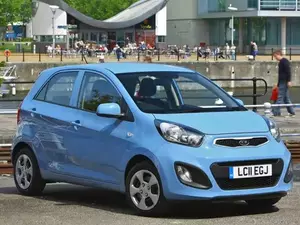
| Vehicle | Curb weight | Difference from world's smallest | Weight to power ratio | 0—60 mph acceleration ratio | Consumption ratio |
|---|---|---|---|---|---|
| 1.0 16V |
840 kg / 1852 lbs |
415 kg (915 lbs) heavier | 12 kg to 1 hp | 61 kg/s (135 lbs/s) |
200 kg/L (441 lbs/L) |
| 1.0 12V LPI |
880 kg / 1940 lbs |
455 kg (1003 lbs) heavier | 11 kg to 1 hp | 64 kg/s (141 lbs/s) |
149 kg/L (329 lbs/L) |
| 1.2 16V |
850 kg / 1874 lbs |
425 kg (937 lbs) heavier | 10 kg to 1 hp | 79 kg/s (174 lbs/s) |
189 kg/L (417 lbs/L) |
| Vehicle | 1.0 16V |
|---|---|
| Curb weight |
840 kg / 1852 lbs |
| Difference from world's smallest | 415 kg (415 lbs) heavier |
| Weight to power ratio | 12 kg to 1 hp |
| 0—60 mph acceleration ratio | 61 kg/s (135 lbs/s) |
| Consumption ratio |
200 kg/L (441 lbs/L) |
| Vehicle | 1.0 12V LPI |
| Curb weight |
880 kg / 1940 lbs |
| Difference from world's smallest | 455 kg (455 lbs) heavier |
| Weight to power ratio | 11 kg to 1 hp |
| 0—60 mph acceleration ratio | 64 kg/s (141 lbs/s) |
| Consumption ratio |
149 kg/L (329 lbs/L) |
| Vehicle | 1.2 16V |
| Curb weight |
850 kg / 1874 lbs |
| Difference from world's smallest | 425 kg (425 lbs) heavier |
| Weight to power ratio | 10 kg to 1 hp |
| 0—60 mph acceleration ratio | 79 kg/s (174 lbs/s) |
| Consumption ratio |
189 kg/L (417 lbs/L) |

| Vehicle | Curb weight | Difference from world's smallest | Weight to power ratio | 0—60 mph acceleration ratio | Consumption ratio |
|---|---|---|---|---|---|
| 1.1i 12V |
966 kg / 2130 lbs |
541 kg (1193 lbs) heavier | 15 kg to 1 hp | 66 kg/s (146 lbs/s) |
197 kg/L (434 lbs/L) |
| 1.0 i 12V |
981 kg / 2163 lbs |
556 kg (1226 lbs) heavier | 16 kg to 1 hp | 63 kg/s (139 lbs/s) |
200 kg/L (441 lbs/L) |
| Vehicle | 1.1i 12V |
|---|---|
| Curb weight |
966 kg / 2130 lbs |
| Difference from world's smallest | 541 kg (541 lbs) heavier |
| Weight to power ratio | 15 kg to 1 hp |
| 0—60 mph acceleration ratio | 66 kg/s (146 lbs/s) |
| Consumption ratio |
197 kg/L (434 lbs/L) |
| Vehicle | 1.0 i 12V |
| Curb weight |
981 kg / 2163 lbs |
| Difference from world's smallest | 556 kg (556 lbs) heavier |
| Weight to power ratio | 16 kg to 1 hp |
| 0—60 mph acceleration ratio | 63 kg/s (139 lbs/s) |
| Consumption ratio |
200 kg/L (441 lbs/L) |